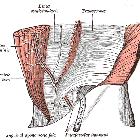Falx inguinalis

The conjoint tendon, also known as Henle's ligament, forms when the medial fibers of the internal oblique aponeurosis unite with the deeper fibers of the transversus abdominis aponeurosis. The conjoint tendon then turns inferiorly and attaches onto the pubic crest and pecten pubis .
Relations
It medially reinforces the posterior wall of the inguinal canal, with the transversalis fascia forming the majority of the posterior wall. It is located directly posterior to the superficial inguinal ring. Laterally, the fibers can fuse with those of the interfoveolar ligament.
Clinical importance
The conjoint tendon may predispose to a direct inguinal hernia if it weakens . Young males with well developed abdominal musculature may be predisposed to a direct hernia known as Busoga hernia (or Gill-Ogilvie hernia) .
Related pathology
Siehe auch:

 Assoziationen und Differentialdiagnosen zu Falx inguinalis:
Assoziationen und Differentialdiagnosen zu Falx inguinalis:
